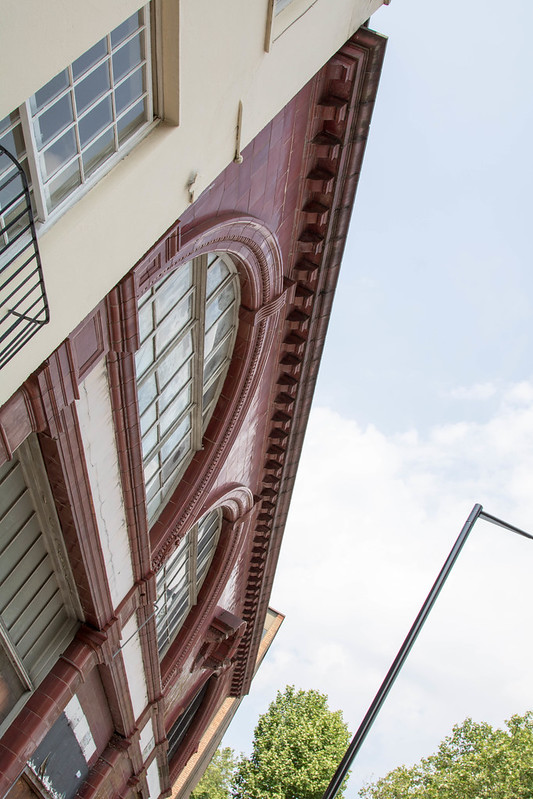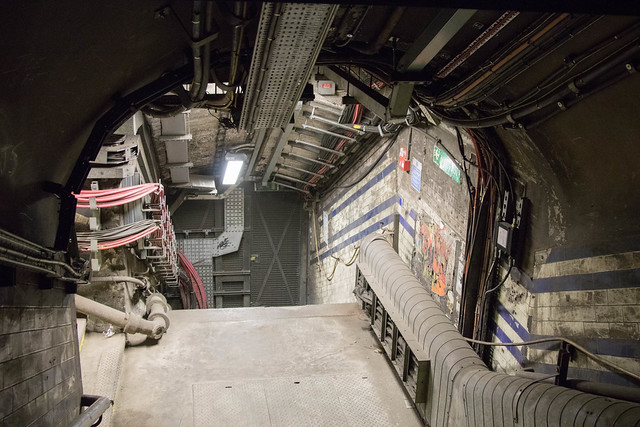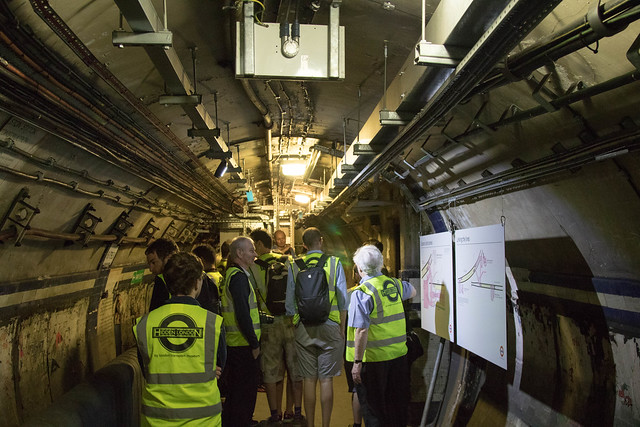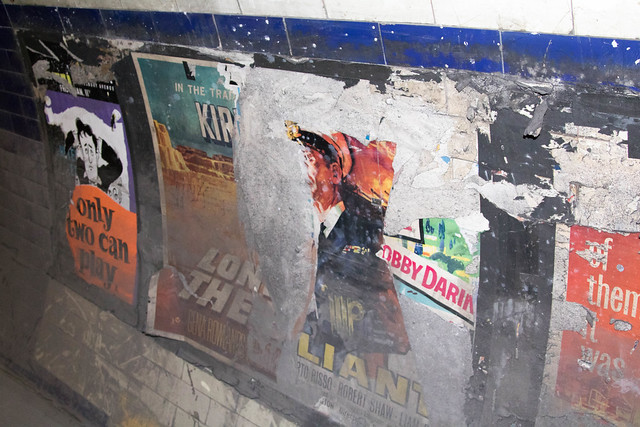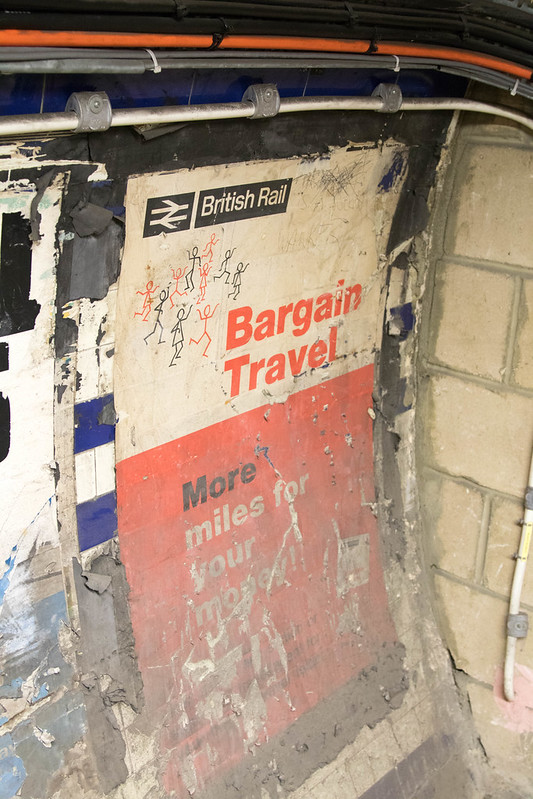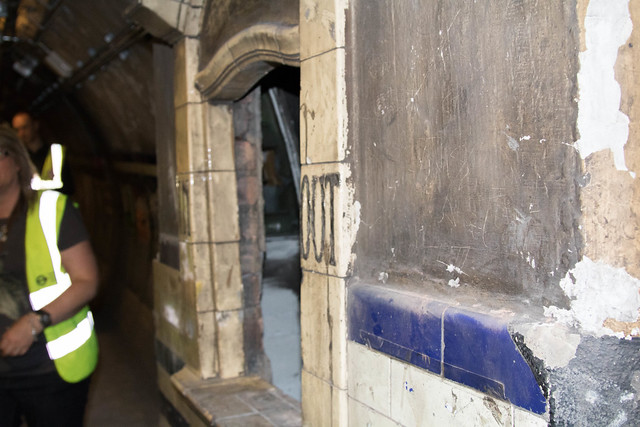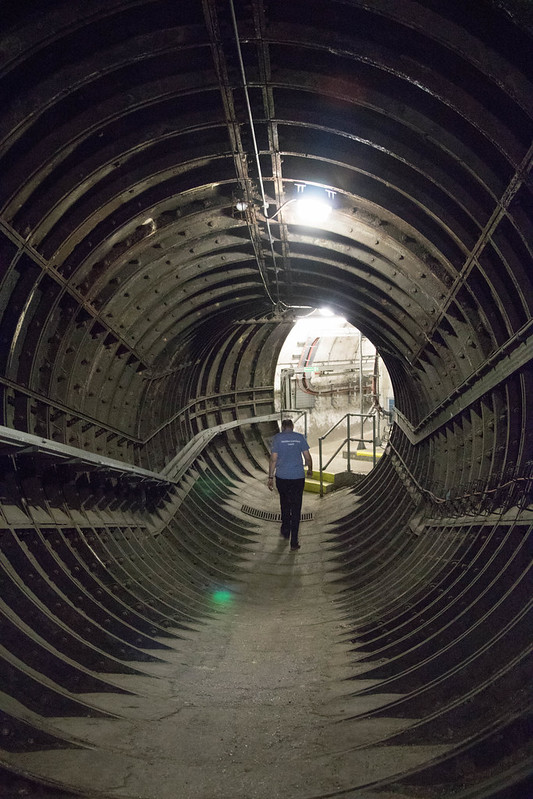Every now and again over the last few years Transport for London (TfL) have opened up a select number of disused stations on a ticketed basis. These were so enormously popular, with tickets selling out so quickly that the London Transport Museum has latterly started advertising them to its mailing list subscribers before putting them on general sale. Even then, getting hold of tickets is a competitive business. So when @Ianvisits, a Blue Badge tourist guide in London (who tweets some really interesting stuff, by the way) tweeted about tours coming up later in 2016 I was put on notice.
Missing this time were the usual tours of Aldwych and the Jubilee line platforms at Charing Cross. I’ve been to Aldwych previously and, while it’s an interesting visit, it’s used so frequently for filming and training that it has never acquired the patina of disuse. And while I’d quite like to see the old Jubilee line platforms at Charing Cross I can quite clearly recall them in use so am happy to leave that particular opportunity for a while.
The other tours on offer were Down Street disused station, the Clapham South deep shelter, TfL’s art deco headquarters at 55 Broadway and the disused tunnels at Euston station. All these sites are interesting, and all places I want to visit, but the future arrival of Crossrail 2 and HS2 mean big changes for Euston, and a significant extension to the south west across Melton Street. It was quite possible that the chance to do this tour would not arise again.
Euston’s early history
Euston of course isn’t a disused station, but in the course of its life it has changed beyond all recognition, and it has some quite substantial disused areas. Euston mainline station opened in 1837 as the terminus of the London and Birmingham railway, connecting London with the Midlands. In 1903 the first deep level underground railway, the City and South London Railway, extended their route from Stockwell northward through the City to a new terminus at Euston. At the same time the Charing Cross Euston and Hampstead Railway arrived, on its route from the west end northwards.
Both stations had their own surface buildings at the south of the mainline station, the C&SLR on the corner of Eversholt Street and Doric Way and the CCEHR on the corner of Melton Street and Drummond Street. There was no interchange between lines, each one being owned by a separate company, and any passenger wishing to do so had to leave one station and walk to the other.
Joint facilities
In 1907 the two companies opened a joint ticket hall, lifts and underground passageways to link the mainline station with the two tube stations. This became popular with passengers and the two surface buildings were closed in 1914 when the companies merged as part of Underground Electric Railways of London (UERL). The two railways subsequently became part of the Northern line, with the C&SLR station on the City branch (via the Bank) and the CCEHR station on the West End branch (via Charing Cross).
Modern Euston
By the mid 1960s the underground station was feeling the strain of an ever increasing number of commuters. As part of the redevelopment of Euston mainline station a new ticket hall with escalators down to new interchange passageways made the old joint facilities redundant. The transfer passageway was closed in 1962, with the lifts and access to the City branch closing in 1968. The lifts were removed, the shafts being converted into ventilation ducts. A new shaft was then dug behind the lifts to provide further ventilation to the brand new Victoria line platforms.
Visiting day
Arriving at the RV point a little early I was able to take a moment to admire UERL architect Leslie Green’s standard station design. There are lots of these dotted around central London and are so familiar they barely merit a second thought, until you have to spend a few minutes lurking around outside one. The recognisable ox blood tiles hide a steel frame, used not only to support the lift gear but, to enable UERL to sell the air rights above their stations, a platform to build on as well.
It’s pleasing to note some of the architectural details, such as this circular window:
Heading inside the station building we were given a safety briefing and a potted history of the site, some of which I have described above. The original fixtures and fittings of the station have long since been removed, the steel frame and lift shafts now housing an enormous ventilation fan. With a 24–105 lens I was not terribly well-equipped to photograph this but this photo hopefully gives an idea of its size.
Down below
We then headed across the road into Euston mainline station and headed downstairs to platform six. Reaching the end of the platform, our guide unlocked a door in the tunnel headwall and took us into another world. Here we are, looking back down at the door we had just through:
In the disused areas, everything is familiar yet different. Usually polished tiles are dirty, and cables and equipment usually hidden is exposed.
Under the grime and the cables lie time capsules in the form of 1960s posters still on the tunnel walls from the date of their last public use.
Walking up the transfer passageway, we arrived at the staircase leading up to the Charing Cross branch platforms, now blocked off. When the new interchange passageways were built in the late 1960s they were at a higher level than the platform; the staircase was reversed, and from the platform now leads up rather than down.
At the end of the transfer passageway can be found this oddity, a transfer ticket office dating back to the days of the C&SLR and CCEHR being separate companies. This must have been a very claustrophobic space in which to work.
Returning along the transfer passageway to the stairs down to platform six, we turned left to head along the passageway to the lifts. As an access route for engineering staff this was much better lit than the transfer passageway which is now effectively a dead end.
At the far end of the passageway are the old lift shafts, visible on the right hand side. Cables run over what seems like every available section of wall.
Turning a corner we found ourselves at a modern wall that has been erected across the passageway — we were to go no further along this corridor.
Looking back past the lifts towards platform six:
Walking into one of the old lift shafts we can see that all the lift equipment has been removed, allowing it to function as a ventilation shaft.
On the other side of the lifts we continued down a series of passages before climbing a steep slope to a level above the Victoria line platforms. We were able to look down through the ventilation grilles onto the platforms.
And with that it was time to go, away from this strangely peaceful place back into the middle of busy central London.
If you want to see a few more photos, or larger versions of the ones shown here take a look at my Flickr album.
Further reading
- Subterranea Britannica: http://www.subbrit.org.uk/sb-sites/sites/e/euston_station/index.shtml
- Abandoned Stations: http://www.abandonedstations.org.uk/Euston_station.html
2021 update: the Hidden London team at the London Transport Museum have made a video about this area of Euston in their YouTube in their series Hidden London Hangouts:

